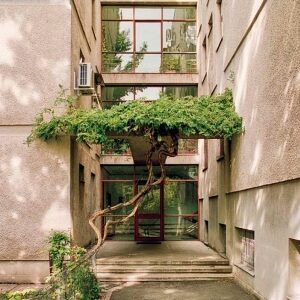Lush; Unnatural Nature: Unusual Depictions of Vegetations and Landscapes.
By Jo Phillips
We have always been used to watching nice paintings, nice depictions showing a vase with flowers, a landscape or a view. But maybe we have also noticed that they were, at the end of the day, very simple and banal, merely faithful representations. What about absurdity? What about strangeness?
This article is going to show unusual and particular depictions of nature, compositions that goes beyond conformity and that will make you travel through nonconformist types of nature
Voynich Manuscript
Awkward plants, mysterious botanic, a vegetation never seen. For who loves mystery this is the right piece to see. The Voynich Manuscript is the most mysterious manuscript in the world. It is written in an unknown writing system, it has been carbon-dated to the early 15th century (1404–1438), maybe composed in Northern Italy during the Italian Renaissance. The manuscript is named after Wilfrid Voynich, a Polish book dealer who purchased it in 1912. There are six different illustration themes: Herbal, Astronomical, Biological, Cosmological, Pharmaceutical and Recipes. All the depictions are very unusual. The herbal part, in particular, reminds the common European herbals of the time, with one or two plants and text paragraphs in the same page. The intriguing fact? None of the plants depicted have been identified.
Ernst Ludwig Kirchner
Ernst Ludwig Kirchner
Bridge at Wiesen
1926
Oil on canvas
119 cm x 120 cm
Kirchner Museum Davos
Ernst Ludwig Kirchner
At the Edge of the Forest
ca 1935
Oil on canvas
50 cm x 50 cm
Kunsthaus Glarus
Emotions distort our perception of reality. Think about it. When we are in a nice mood everything seems bright, beautiful and clear, while when we are in a bad mood everything seems hostile, obscure and bitter. The Expressionists, such as Kirchner, painted a reality based on what the inner eye saw, the eye of our soul and mind. The paintings of Kirchner are a mixture of disturbing landscapes, a nature overwhelmed by the feelings, charged with striking colours and complex shapes. Watching Kirchner’s natures is like walking through a nightmare, a thriller location where our feelings make everything around us alive, responding to our moods.
Ernst Ludwig Kirchner
Laburnum Tree
1912-13
Oil on canvas
101.5 cm x 76 cm
Colby College Museum of Art
Giuseppe Arcimboldo
Giuseppe Arcimboldo
Four Seasons in One Head
ca 1590
Oil on canvas
44.7 cm x 60.4 cm
National Gallery of Art, Washington DC
Giuseppe Arcimboldo
Spring
1573
Oil on Canvas
76 × 64 cm
Louvre Museum, Paris
There is an artist who is unique for the compositions he made. The Mannerist painter Giuseppe Arcimboldo is famous in the history of art for his bizarre compositions. The Grotesque, bizarre and puzzling were the typical features of Renaissance, and Arcimboldo managed to convey them on his canvases. He created portraits mixing together elements of nature, creating awkward but fascinating depictions. Spring is a man made of flowers; Wertumnus, the god of seasons, is made of flowers and vegetables; the embodiment of the four seasons has trees and plants, flowers and fruits all together. It’s an unnutural but at the same time naturalistic composition that transmits a sense of mystery and symbolism.
Giuseppe Arcimboldo
Vertumnus
1591
Oil on canvas
700 mm x 580 mm
Skokloster Castle, Sweden
Gustav Klimt
Gustav Klimt
The Tree of Life
1909
Oil on canvas
195 cm × 102 cm
Museum of Applied Arts, Vienna, Austria
Gustav Klimt
The Sunflower
1906 – 1907
Oil on canvas
110 x 110 cm
Private Collection
Klimt is one of the main exponents of the Art Nouveau. His art is imbued with symbolism and decoration elements. He uses a lot of gold and fine colours creating very exquisite compositions. Nature is also overwhelmed by symbolism and decoration hints. Klimt perceived a certain delight in the opulence and abundance of nature. Nature in Klimt oeuvre is full of details and fine elements. Flowers look like precious gems or tesserae of a mosaic. Plants and vegetation become geometric shapes that seem to adorn a particular reality in which natural subjects become unnatural, charged in their symbolism and decorative hues.
Gustav Klimt
Garden Path with Chicken
1916
Oil on canvas
110 x 110 cm
Destroyed by a fire set by retreating German forces in 1945 at Schloss Immendorf, Austria.
Paul Cézanne
Paul Cézanne
Mont Sainte-Victoire
ca 1887
Oil on canvas
67 × 92 cm
Courtauld Institute of Art, London
Paul Cézanne
The Aqueduct
1897-1900
Oil on canvas
91 cm x 71 cm
The Pushkin State Museum of Fine Arts, Moscow
Paul Cézanne is a Postimpressionist painter. He took inspiration from the Impressionists for their techniques and subjects. However, the Impressionists thought that reality was fugitive and transient. They wanted to catch a particular moment, a particular light, because they knew that everything flows, changes, so every second was important, an the same subject moment after moment was already in the process of changing. Cézanne did not share the same conception. He thought that there must be something solid, sure and certain in this life. He wants certainties. If everything is fugitive and is transient, where identity and solidity take place? For this reason Cézanne introduced geometric figures in his compositions. His figures but also his landscapes are overwhelmed by geometric shapes that give a sense of solidity and firmness. Trees, mountains, plants, everything is imbued with geometry. In fact the painter’s nature is not properly realistic, he is not interested in naturalism, but in the certain emotions and the certain identity that the landscape enshrine. An identity that is solid and resists the fugitive passing of time. Cézanne, for his introduction of geometry in the compositions, is indeed considered the forerunner of cubism.
Paul Cézanne
Le Lac d’Annecy
1896
Oil on canvas
81 x 65 cm
The Courtauld Gallery, London




















